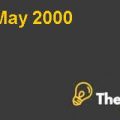Markov’s Trilemma Case Solution
Introduction:
The objective of this case is to identify the optimal asset allocation of different asset classes that help to decide the optimal investment that gives higher return with minimum risk, considering the expected return of the portfolio and the expected standard deviation of portfolio as well as the Sharpe ratio which gives excess return with excess volatility in of different assets. Sharpe ratio is calculated as the expected return of portfolio minus risk-free rate divided by expected portfolio standard deviation. The portfolio diversification is also decided by making various changes and adding constraints.
Three assets Optimizer:
Sharpe ratio is used for the risk return adjustment, as well as it becomes the standard of industry ratio. Sharpe ratio does not give the normal distribution of portfolio return.
| Weighting | Expected | Standard | Sharpe | Correlation Coefficient with: | |||
| Asset | Return | Deviation | Ratios | GM | MRK | GE | |
| GM | 0.33 | 21.3% | 37.6% | 0.38 | 1.00 | 0.12 | 0.26 |
| MRK | 0.34 | 41.3% | 30.1% | 1.14 | 0.12 | 1.00 | 0.30 |
| GE | 0.33 | 41.0% | 24.0% | 1.42 | 0.26 | 0.30 | 1.00 |
| 1.00 |
Table 1: W1=33%, W2=34%, W3=33%
Sharpe ratio of Markov Trilemma results in 1.30 by using risk free rate of 7%, whichshows expected return of 34.6% and expected standard deviation of 21.3%.
| Weighting | Expected | Standard | Sharpe | Correlation Coefficient with: | |||
| Asset | Return | Deviation | Ratios | GM | MRK | GE | |
| GM | 0.30 | 21.3% | 37.6% | 0.38 | 1.00 | 0.12 | 0.26 |
| MRK | 0.40 | 41.3% | 30.1% | 1.14 | 0.12 | 1.00 | 0.30 |
| GE | 0.30 | 41.0% | 24.0% | 1.42 | 0.26 | 0.30 | 1.00 |
| 1.00 |
Table2:W1=30%, W2=40%, W3=30%
By changes in the weights of three companies in the same industry as shown in Table 2, allocating weights of 30% of GM, 40% of MRK and 30% of GE resulted in Sharpe ratio of 1.33, which is slightly higher than table 1 weight ages (such as: 33% of GM, 34% of MRK and 33% of GE). On the other hand,using same risk-free rate of 7%, however due to the changes in weights the expected return and expected standard deviation are also changed. Expected portfolio return is 35.2% and the expected standard deviation is 21.2% which results in high Sharpe ratio of 1.33.
Weights of different assets in line with the expectation:
GM has decided for diversified corporation with GE, therefore its correlation would become 0.80 instead of 0.26. If the correlation is 0.26 in diversified conglomeration with the given weights (i.e. W1=33%, W2=34% and W3=33%), then Sharpe ratio would be 1.30.
Correlation is 0.80 between GE and GM instead of 0.26:
| Weighting | Expected | Standard | Sharpe | Correlation Coefficient with: | |||
| Asset | Return | Deviation | Ratios | GM | MRK | GE | |
| GM | 0.33 | 21.3% | 37.6% | 0.38 | 1.00 | 0.12 | 0.80 |
| MRK | 0.34 | 41.3% | 30.1% | 1.14 | 0.12 | 1.00 | 0.30 |
| GE | 0.33 | 41.0% | 24.0% | 1.42 | 0.80 | 0.30 | 1.00 |
| 1.00 |
Table3: Correlation between GM and GE is 0.80
If the correlation is changed to 0.80 between GM and GE, while having the same weights,then Sharpe ratio would decrease to 1.17 due to the increase in expected return, which is directly proportion to Sharpe ratio, while having same risk free rate. The expected standard deviation is also increased to 23.6% but an expected standard deviation is increased more than expected return which is why Sharpe ratio is declined to 1.17. This shows the risk return adjustment between the GM and GE is low as compare to normal distribution conglomerate of 0.26.
Correlation is- 0.80 between GE and GM instead of 0.26:
| Weighting | Expected | Standard | Sharpe | Correlation Coefficient with: | |||
| Asset | Return | Deviation | Ratios | GM | MRK | GE | |
| GM | 0.33 | 21.3% | 37.6% | 0.38 | 1.00 | 0.12 | (0.80) |
| MRK | 0.34 | 41.3% | 30.1% | 1.14 | 0.12 | 1.00 | 0.30 |
| GE | 0.33 | 41.0% | 24.0% | 1.42 | (0.80) | 0.30 | 1.00 |
| 1.00 |
Table 4: Correlation between GM and GE is -0.80...............
This is just a sample partial case solution. Please place the order on the website to order your own originally done case solution











